
By clicking “Accept All Cookies”, you agree to the storing of cookies on your device to enhance site navigation, analyze site usage, and assist in our marketing efforts Cookies Policy.
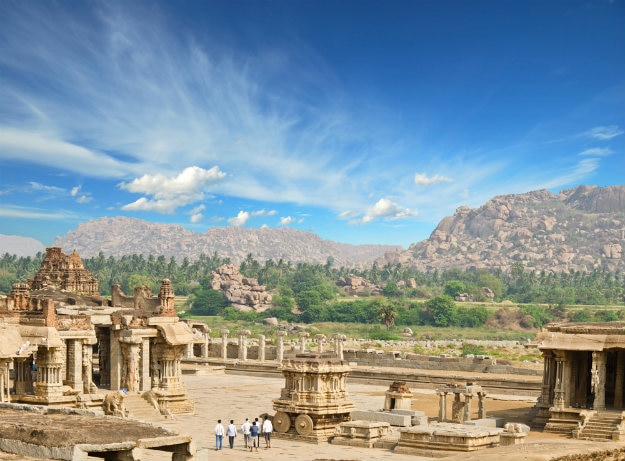
Hampi, a village and a temple town in Karnataka is one of the most historically rich places. Listed under the UNESCO World Heritage Site as the Group of monuments at Hampi, this city was also at one point one of the richest cities in the world when it was at its peak. Located inside the Vijayanagara city, Hampi has been one of the most significant tourist places of attraction. People from all over the country visit Hampi for its beautiful monuments and history. As per statistics of the year 2014, Hampi is said to be the most searched places of Karnataka online. People who visit Hampi are mostly people who love history and architecture. It is no surprise that Hampi is such a famous place for tourists that visit from all over the globe. Visit Hampi at any time of the year and you will see the place swarming with people. We will take you through the fascinating history of the city of Hampi and also the Vijayanagara Empire. First, let us tell you a little about Hampi.
ALSO READ Hampi: The imperial city
History
Hampi is also known as Pampa Kshetra, Kishkindha kshetra and even Bhaskara kshetra. These names were derived from the famous Tungabhadra River Pampa. According to mythology, it is said that Pampa was Brahmas daughter who was later married off to Shiva. It was here where the city was built. Hampi word in is another version of Hampe, a Kannada name. Today, Hampi is also known as Vijayanagara who used to rule the city. As you walk through the remains of Hampi’s magnificent forts, palaces and gateways, you will get a glimpse of the excellent architecture of those times. The monuments speak volumes about the history of Hampi that used to be a prosperous and rich kingdom in the 14th century which was eventually ruined owing to the attacks made by the Moghuls.
The history of Hampi dates back to the 2nd and also the 3rd century that is the Neolithic and Chalcolithic era. This fact has been established from the ceramic potteries that have been found here from those centuries. The popular folklore is that two local chiefs called Hakka and Bukka one on a hunting expedition report of an unusual sighting to their guru Vidyaranya. And the fascinating sight was that of a hare who was being chased by their hound. The hare suddenly becomes all brave and powerful and turns around to chase the hound. This made the Guru believe that the place where they found this unusually beautiful sight is very special and hence decided to shift their local capital to this very place. This was the start of an empire that went on to become one of the richest. In a span of over 200 years, a total of four dynasties ruled Vijayanagar that is also called the City of Victory.
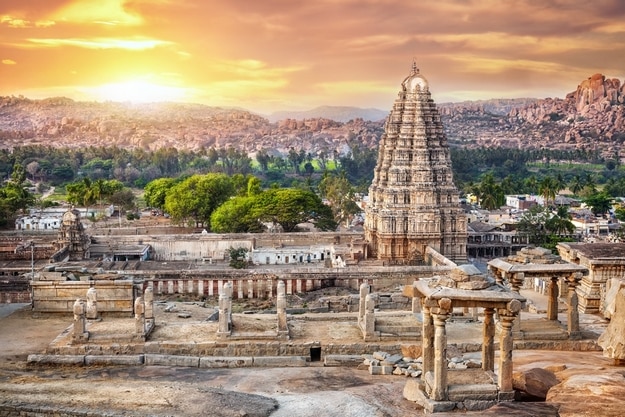
At one point Hampi was also one of the biggest trading centers of the world. Vijayanagar brought a lot of wealth, fame and splendor to Hampi. In those times, most markets in Hampi were always crowded and swarming with buyers and also merchants. These merchants were not just Indians, but also people from various parts of the world. In no time, the markets grew tremendously and goods were exchanged for spices and cotton. In ancient times, the currencies were all silver and gold.
ALSO READ 9 lesser known facts about Hampi!
Hampi was also rich in art and architecture. The rulers who ruled the region were great lovers of religion and art and hence most Kings put in a lot of effort to set up magnificent empires using one of the best architectural designs, which is for you to see now. Hampi had reached its prime during the rule of Krishna Deva Raya who ruled this city between 1509 and 1529. This was the same period when international trading had flourished and reached great heights under the progressive trading practices and also several international trade agreements that were carried out. During this era, Vijayanagara Empire had almost taken up most of South India and also beyond. However, Hampi succumbed to the attacks carried out by five Deccan Sultans called Bidar, Bijapur, Ahmednagar, Golconda and also Berar. They attacked Hampi in 1565 and looted them for a long period, approximately six months. An attack of six months long definitely had to bring such massive destruction that it would have taken them forever to rise again. The temples of Hampi were damaged and most of the markets were robbed. This was one of the biggest attacks that Hampi witnessed and their golden era with this came to an end. After the attacks, the empire was ruled by different Kings; however, nobody really could bring back the lost glory.
The city did function, but it had lost its strategic importance and thus got lost in time. Even today, the loss and destruction of the 1565 attacks can be seen in many parts of the city. During the colonial period, Hampi had stirred up some curiosity in the mind of archaeologists from abroad. For those who love watching ancient historical stories, you must definitely watch Robert Sewells A forgotten Empire Vijayanagar that was made as an attempt to narrate the incidents that occurred during their ruling. Also, there is a travel guide that was also the first-ever, named Hampi’s Ruins Described and Illustrated by Longhurst. In today’s time, the monuments, which are almost hundreds of them, are very popular among tourists as well as pilgrims.
The Vijayanagara Empire is said to have been established and founded by Bukka and Harihara who were also known as Sangama brothers. The brothers initially lived in Warangal where they were working as treasurer and minister. In 1323, the brothers fled Warangal when the city was attacked by the Muslims and went to Kampili. They fled from there too again owing to the attacks by Muslims and crossed River Tungabhadra to form a new city which is now known as Vijayanagara. This city was ruled by four different dynasties from 1336 to 1565. Sangam dynasty, Saluva Dynasty, Tuluva Dynasty and Aravidu Dynasty were the four dynasties in ruling during that period. The kings and princes of each of these dynasties made sure that while in their ruling, they do whatever it takes to brings richness and wealth to the city and ended up building over 500 monuments. And because Hampi was the capital, it flourished in trade. We have listed down the four different dynasties with small information about each one of them.
ALSO READ How to travel from Bangalore to Hampi by road
Sangama Dynasty was founded by Bukka Raya 1 and Harihara 1. The ruling passed on from them to Harihara II and Devaraya II and several others.
The Saluva dynasty was ruled only by two rulers in the name of Saluva Narasimha Deva and Immadi Narasimha.
The Tuluva Dynasty was the third in a row to rule the Vijayanagara Empire. Immadi Marasimha who initially ruled the dynasty was killed by Vira Narasimha who then took over the throne and made the Tuluva dynasty in 1505.
The Aravidu Dynasty is the last dynasty of the Vijayanagara Empire and Tirumala was the founder. This dynasty was defeated and taken over Bijapuri Muslims.
Before the Vijayanagar Kings rose in this area, the city was ruled by Kampili and his chiefs. Kampili is now a quaint town that is situated 19 km on the east of Hampi. It was Colin Mackenzie who discovered the ruins of Hampi in 1800. The Archeological Survey of India still does many excavations to discover the many beautiful temples and also other artifacts.
Mythological significance of Hampi:
Hampi also has a strong mythological story associated with it. And if these beliefs are anything to go by, it is said that the Kishkinda Vanara Kingdom is where Ram and Lakshman had stayed when they had set out in search of Sita who was abducted by Ravana. You will also find several spectacular mountains that are said to be spots where Ram, Hanuman, Sugreeva and Vali stayed. And because we are talking of Ramayana and its association with Hampi, the first thing that comes to mind is the Hazara Ram temple at Hampi that is one of the thousands of temples here. The word Hazara was derived from a Telugu word Hazarumu that also means an Entrance hall. If you have ever visited Hampi or if you are planning to make a trip son, you will find many intricately done carvings that depict a lot about Ramayana and the many stories surrounding the same. The Hazara Temple used to be a private temple to the royal family of those times.
ALSO READ Guesthouses and hotels in Hampi for every budget
The famous temples and monuments of Hampi:
Since Hampi is popular all over the world for its beautiful monuments and temples, here are some of them that you need to explore on your visit.
Virupaksha Temple
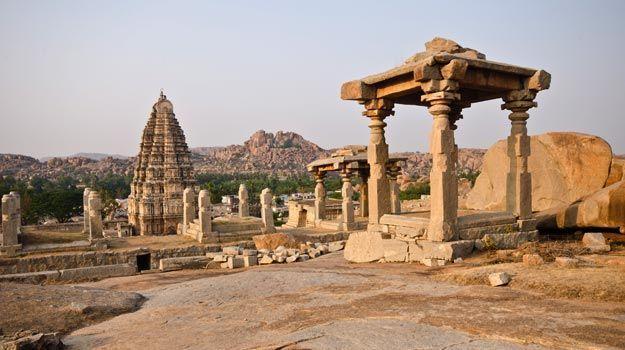
When in Hampi make sure to visit the Virupaksha temple that will be a treat to the eyes for people who love history and religion. Located on the banks of the beautiful Tungabhadra and is a part of the Group of Monuments in Hampi. And since it is also a part of the UNESCO World Heritage site, there is no doubt that the beauty and charm of this temple are still eye-catching. The inscriptions that you will find on the structure go back to the 9th and 10th centuries. Built in dedication to Shiva, this site is one of the most important and visited pilgrim sites. When the temple was first built it was small however during the ruling period of the Vijayanagara Empire, the temple was extended. You must have read a lot about Hampi no longer having the same beauty as before, however, this temple is still beautiful and the sights of its architectural beauty is worth watching. The Virupaksha temple is also famously known as the Pampvathi temple and is exactly situated in the Hampi Bazaar. The most fascinating part about this temple is the stunning three gopuras and also a big high tower that stands tall at 160 feet hat is the main entrance. The temple also has an elephant called Lakshmi.
Vijaya Vittala Temple
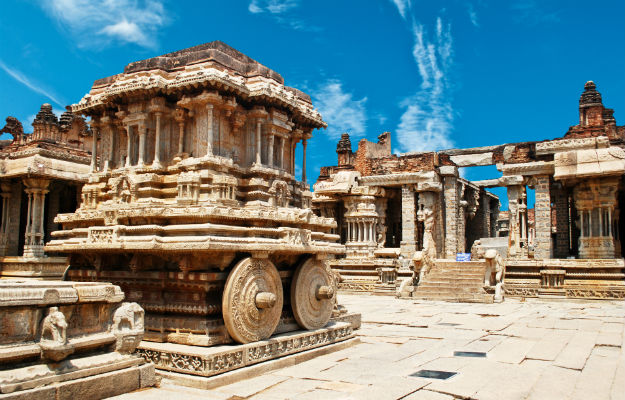
Among the many Hampi attractions, the Vijaya Vittala temple is one of the most breathtaking pieces of architecture. Built in dedication to Vittala who is a form of Vishnu, you must explore this temple if you love architecture. You dont really have to be a believer to be here. The several hallways, gateway, towers and pavilions make this temple very beautiful. The Vittala temple was built in the 15th century and many kings who ruled have tried their best to further enhance the beauty of this temple, and thus, it because of their efforts that Hampi was gifted with such a beautiful structure. The highlight of the Vittala temple is the stone chariot. It is almost considered as an iconic structure of Hampi. It also has musical pillars that are as iconic as the stone chariot. Each pillar of this temple depicts a musical instrument and also serves as the main support for the whole structure. This has been arranged around the main pillar of the temple which when struck gives out the 7 notes from each of the instruments that it represents.
The British found this pretty suspicious and went on to cut open the pillar to find out if there was anything hidden that produces the sound. However, on cutting it open they found nothing and it is considered as a miracle. The cut made by the British can still be seen. This temple is also a venue for the famous festival Purandaradasa festival that is held there annually.
ALSO WATCH This video captures the beauty of the ruins of Hampi like no other!
The Kings Balance
Another great attraction is the Kings balance which is also famously called Tulapurushandana. It is situated on the southwest of the Vitala temple what we mentioned above. The Kings balance is just five meters tall and forms an archway like structure. The structure has been carved from stone and it is believed by many that during the lunar and solar eclipse and also during Dussehra, the King was weighed with gold and many other precious stones. These jewels were then given away to the priests of the temple. If you look closely you will also find three loops that may have been used by the King to hang on the swing and weigh. You will also find an image of the King on one of the pillars. The image carved is assumed to be that of King Krishna Deva Raya and his wives. The weighting procedure is also called Tula Bhara which is even today followed in many temples.
Achyutaraya Temple
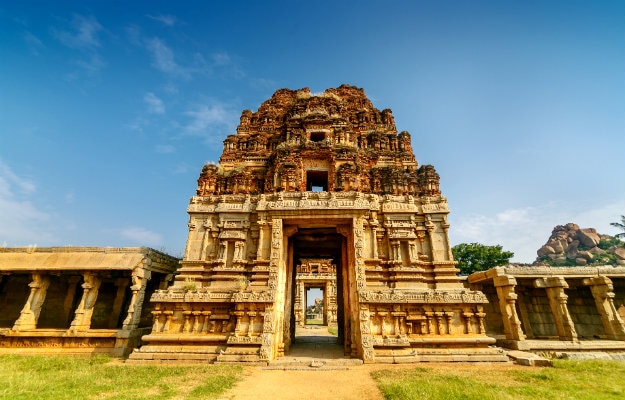
Built and sanctified in AD 1534, the Achyutaraya temple is a classic example of the Vijayanagar style of architecture. The architecture used in this temple is much advanced in comparison to the other structures in Hampi. And it is said; the Achyutaraya temple was the last grand temple to be built before the empire fell and got defeated in the hands of Sultans. This temple is also dedicated to another form of Vishnu- Tiruvengalanatha and was set up and built by an officer in Achyuta Rayas court and that’s how the temple got its name. Situated between two stunning hills namely- Gandhamadana and Matanga Hills, the scenic beauty is sure to leave you awestruck. The temple courtyard is lined by intricately carved pillars and the temple also houses an antarala, rangamantapa and also garbhagriha. This is one of the many temples in Hampi that you must explore on your visit to this religiously and historically significant place.
Archaeological Museum in Hampi
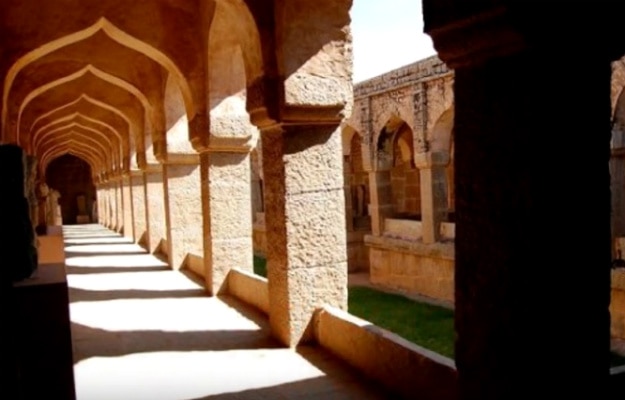
The very first museum that was built and set up by the Archeological Survey of India is this beautiful Archaeological Museum in Hampi. The museum exhibits ancient sculptures and also many artifacts and this is where you will get a glimpse of the history of Hampi. If you are a history buff, a visit to this museum is sure to leave you satisfied and awestruck. From silver coins to sculptures of several deities and gold coins, there is a lot that you will get to see here. There are different galleries that display different precious stones and sculptures. You will have to pay a fee of Rs 5 per head to explore this beauty.